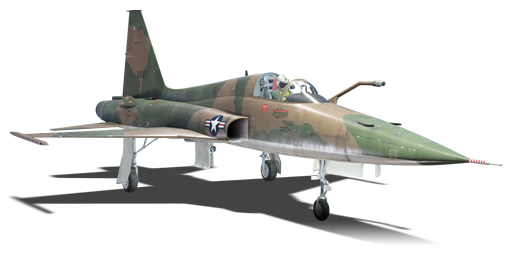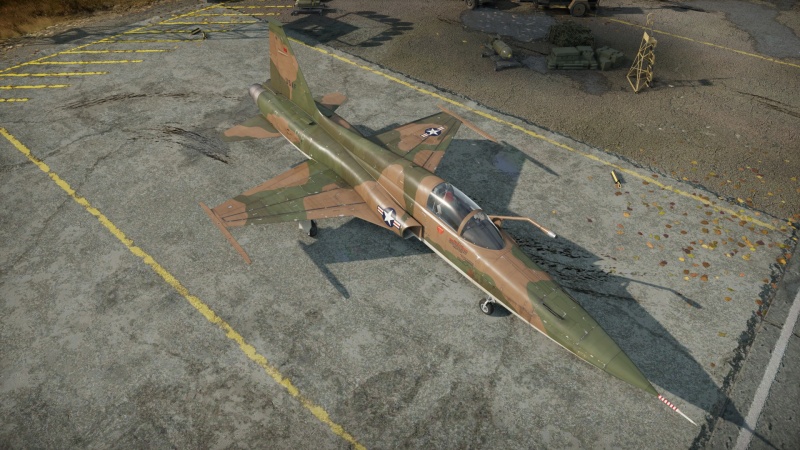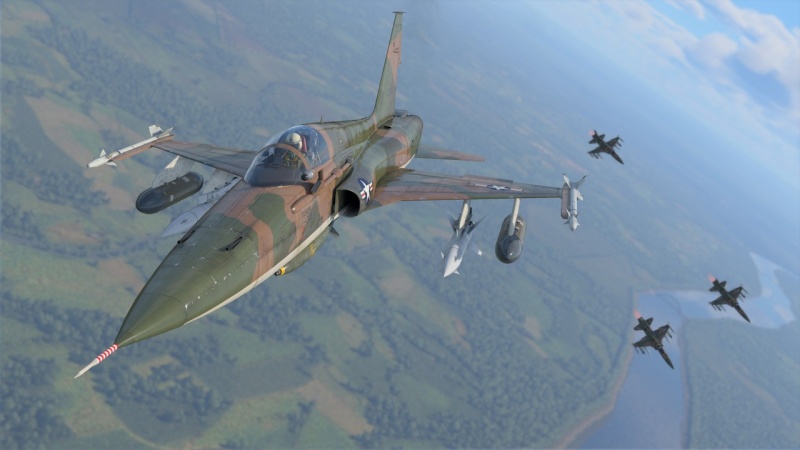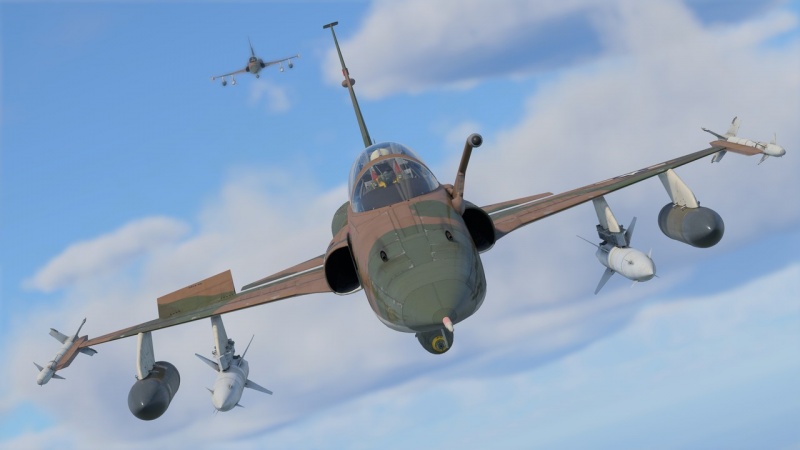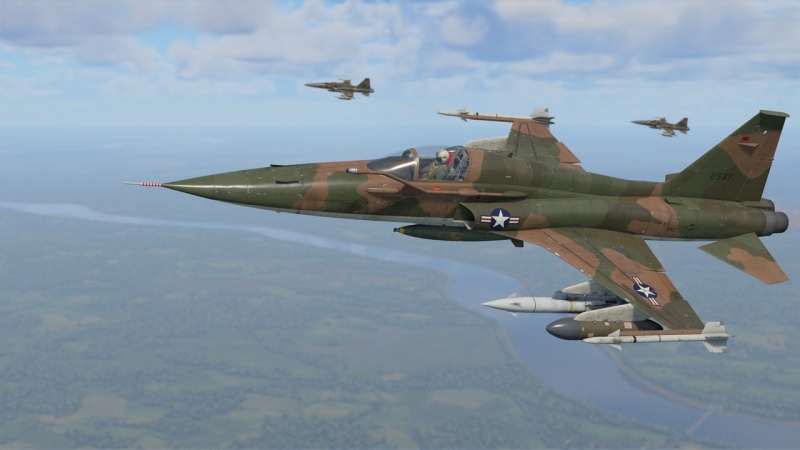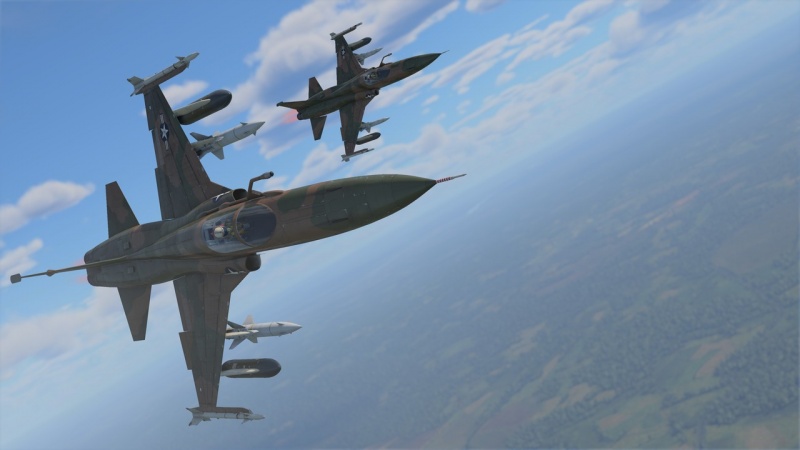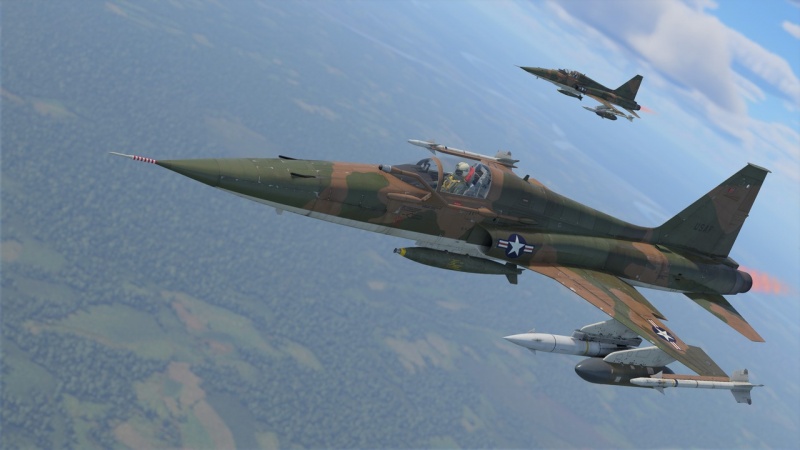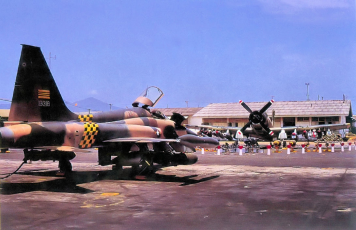F-5C
Contents
Description
The F-5C Skoshi Tiger is a premium gift rank VII American jet fighter with a battle rating of 10.3 (AB) and 10.7 (RB/SB). It was introduced in Update "Red Skies".
General info
Flight performance
The F-5C is generally an all-round good fighter. Its not the fastest plane and not the most manoeuvrable.
| Characteristics | Max Speed (km/h at 10,668 m) |
Max altitude (metres) |
Turn time (seconds) |
Rate of climb (metres/second) |
Take-off run (metres) | |||
|---|---|---|---|---|---|---|---|---|
| AB | RB | AB | RB | AB | RB | |||
| Stock | ___ | ___ | 15240 | __._ | __._ | __._ | __._ | 850 |
| Upgraded | 1,460 | 1,443 | 26.9 | 27.0 | 159.1 | 133.6 | ||
Details
| Features | |||||
|---|---|---|---|---|---|
| Combat flaps | Take-off flaps | Landing flaps | Air brakes | Arrestor gear | Drogue chute |
| ✓ | ✓ | ✓ | ✓ | X | ✓ |
| Limits | ||||||
|---|---|---|---|---|---|---|
| Wings (km/h) | Gear (km/h) | Flaps (km/h) | Max Static G | |||
| Combat | Take-off | Landing | + | - | ||
| 1458 | 444 | 926 | 560 | 555 | ~11 | ~5 |
| Optimal velocities (km/h) | |||
|---|---|---|---|
| Ailerons | Rudder | Elevators | Radiator |
| < 680 | < 750 | < 700 | N/A |
Engine performance
| Engine | Aircraft mass | ||||||
|---|---|---|---|---|---|---|---|
| Engine name | Number | Basic mass | Wing loading (full fuel) | ||||
| General Electric J85-GE-13 | 2 | 4,051 kg | 366 kg/m2 | ||||
| Engine characteristics | Mass with fuel (no weapons load) | Max Takeoff Weight | |||||
| Weight (each) | Type | 11m fuel | 20m fuel | 30m fuel | 37m fuel | ||
| 271 kg | Afterburning axial-flow turbojet | 4,580 kg | 4,992 kg | 5,463 kg | 5,814 kg | _,___ kg | |
| Maximum engine thrust @ 0 m (RB/SB) | Thrust to weight ratio @ 0 m (WEP) | ||||||
| Condition | 100% | WEP | 11m fuel | 20m fuel | 30m fuel | 37m fuel | MTOW |
| Stationary | 960 kgf | 1,426 kgf | 0.62 | 0.57 | 0.52 | 0.49 | _.__ |
| Optimal | 1,200 kgf (1,400 km/h) |
2,459 kgf (1,400 km/h) |
1.07 | 0.99 | 0.90 | 0.85 | _.__ |
Survivability and armour
Examine the survivability of the aircraft. Note how vulnerable the structure is and how secure the pilot is, whether the fuel tanks are armoured, etc. Describe the armour, if there is any, and also mention the vulnerability of other critical aircraft systems.
Modifications and economy
Armaments
Offensive armament
The F-5C is armed with:
- 2 x 20 mm M39A2 cannons, nose-mounted (280 rpg = 560 total)
Suspended armament
The F-5C can be outfitted with the following ordnance:
- Without load
- 2 x AIM-9E Sidewinder missiles
- 2 x AIM-9E Sidewinder missiles + 18 x 250 lb LDGP Mk 81 bombs (4,500 lb total)
- 2 x AIM-9E Sidewinder missiles + 5 x 500 lb LDGP Mk 82 bombs (2,500 lb total)
- 2 x AIM-9E Sidewinder missiles + 5 x 750 lb M117 cone 45 bombs (3,750 lb total)
- 2 x AIM-9E Sidewinder missiles + 3 x 1,000 lb LDGP Mk 83 bombs (3,000 lb total)
- 2 x AIM-9E Sidewinder missiles + 1 x 2,000 lb LDGP Mk 84 bomb (2,000 lb total)
- 2 x AIM-9E Sidewinder missiles + 8 x Zuni Mk32 Mod 0 ATAP rockets
- 2 x AIM-9E Sidewinder missiles + 8 x Zuni Mk32 Mod 0 ATAP rockets + 2 x AGM-12B Bullpup missiles
- 2 x AIM-9E Sidewinder missiles + 8 x Zuni Mk32 Mod 0 ATAP rockets + 38 x FFAR Mighty Mouse rockets
- 2 x AIM-9E Sidewinder missiles + 8 x Zuni Mk32 Mod 0 ATAP rockets + 6 x 250 lb LDGP Mk 81 bombs (1,500 lb total)
- 2 x AIM-9E Sidewinder missiles + 8 x Zuni Mk32 Mod 0 ATAP rockets + 3 x 500 lb LDGP Mk 82 bombs (1,500 lb total)
- 2 x AIM-9E Sidewinder missiles + 8 x Zuni Mk32 Mod 0 ATAP rockets + 3 x 750 lb M117 cone 45 bombs (2,250 lb total)
- 2 x AIM-9E Sidewinder missiles + 8 x Zuni Mk32 Mod 0 ATAP rockets + 1 x 1,000 lb LDGP Mk 83 bomb (1,000 lb total)
- 2 x AIM-9E Sidewinder missiles + 76 x FFAR Mighty Mouse rockets
- 2 x AIM-9E Sidewinder missiles + 76 x FFAR Mighty Mouse rockets + 6 x 250 lb LDGP Mk 81 bombs (1,500 lb total)
- 2 x AIM-9E Sidewinder missiles + 76 x FFAR Mighty Mouse rockets + 1 x 750 lb M117 cone 45 bomb (750 lb total)
- 2 x AIM-9E Sidewinder missiles + 38 x FFAR Mighty Mouse rockets + 3 x 750 lb M117 cone 45 bombs (2,250 lb total)
- 2 x AIM-9E Sidewinder missiles + 76 x FFAR Mighty Mouse rockets + 1 x 1,000 lb LDGP Mk 83 bomb (1,000 lb total)
- 2 x AIM-9E Sidewinder missiles + 4 x AGM-12B Bullpup missiles
- 2 x AIM-9E Sidewinder missiles + 2 x AGM-12B Bullpup missiles + 3 x 500 lb LDGP Mk 82 bombs (1,500 lb total)
- 2 x AIM-9E Sidewinder missiles + 2 x AGM-12B Bullpup missiles + 3 x 750 lb M117 cone 45 bombs (2,250 lb total)
- 2 x AIM-9E Sidewinder missiles + 2 x AGM-12B Bullpup missiles + 38 x FFAR Mighty Mouse rockets + 1 x 750 lb M117 cone 45 bomb (750 lb total)
- 2 x AIM-9E Sidewinder missiles + 2 x AGM-12B Bullpup missiles + 38 x FFAR Mighty Mouse rockets + 1 x 500 lb LDGP Mk 82 bomb (500 lb total)
- 2 x AIM-9E Sidewinder missiles + 2 x AGM-12B Bullpup missiles + 38 x FFAR Mighty Mouse rockets + 1 x 1,000 lb LDGP Mk 83 bomb (1,000 lb total)
Usage in battles
In air RB, the F-5C can be played as both a support and offensive plane. In medium range engagements, it plays well as a support fighter, either baiting enemies to use up missiles with the large amount of flares/chaff or launching missiles at enemies who are chasing friendly aircraft to give a chance to let your teammate get in a better position. In close range engagements, with some effort you can stay on the tail of the enemy, if possible making the enemy pull as many manoeuvres as possible to slow them down so you can get a short burst from the respectable 20 mm cannons mounted in the nose. Due to the plane's characteristics, overshooting an enemy won't be the end of a dogfight, the F-5C is able bleed enough speed in a quick turn to get right back on the enemy if they don't take avantage of the overshoot or if they are going too slow to be able to make any quick counterattack.
In mixed ground battles (RB), the F-5C is able to function as a light strike aircraft, while also being able to maintain air supremacy. The F-5Cs versatile loadout of air to ground ordinance allows the player to choose what range they want to do air support, for example the 4x AGM-12B loadout is great for medium range engagements with the enemy ground units. Its largest downfall as a light strike aircraft is the lack of RWR, so SPAA are easily able to deal with a pilot that does not notice them fast enough.
Pros and cons
Pros:
- Good top speed
- Light and small
- Has countermeasures
- Guns are effective
Cons:
- Only gets AIM-9Es while the Chinese equivalent gets AIM-9Ps
- No radar
History
In 1965, after the outbreak of the Vietnam War, the U.S government decided to send troops to South Vietnam to counter the threat of North Vietnam forces. At that time, many tactical wings of USAF were sent to Thailand and South Vietnam for Operation Rolling Thunder, also they need to support the South Vietnam Army to counter those Viet Cong forces in the South Vietnam area. In the meantime, many countries were doubted that if they really need to buy a fighter that wasn’t chosen by USAF before, so USAF decided to let Colonel Frank Emory lead a special provisional squadron named 4503rd Tactical fighter squadron to take the new F-5 fighters into the Vietnam War because it provides an excellent chance to prove that F-5 could do its job well in regional conflicts, this combat evaluation project was named Skoshi Tiger.
To extended the combat capability of Skoshi Tiger, Northrop did some modifications on the original F-5A Freedom Fighter, such as an external fixed refueling probe on the left side of the forward fuselage that could receive fuel from KC-135 tanker to extend the combat radius for some long-range missions, the total weight of Skoshi Tiger’s in-flight refueling system was 85 pounds, also the in-flight refueling system could be removed if necessary. To improve the survival ability of Skoshi Tiger from the enemy’s ground fire, two 1/4 inch-thick face-hardened steel armor plate was mounted externally on the fuselage, the function of the front plates was to protect the pilot and control mechanism, and the after plates was to protect vital hydraulic and control areas near the tail section, which added 236 pounds to the overall weight, there were five jettison-able pylons in total under wings and fuselage like the original F-5A Freedom Fighter, other improvements such as better throttle linkage for improved afterburner modulation and the deletion of the rudder limiter were also implemented on the Skoshi Tiger.
The official name of "Skoshi Tiger" is F-5C. Five F-5A-15 and seven F-5A-20 originally destined to allied countries were withdrawn and sent to 4503rd Tactical Fighter Squadron after received those modifications, also some sources claim that USAF wanted 200 F-5 fighters which could be used in Vietnam War, in which the Skoshi Tiger program will be divided into three parts, and 4503rd Tactical Fighter Squadron was the first part who will be sent to Bien Hoa AFB to attack the ground targets in South Vietnam. (According to different source, not only the 12 F-5C Skoshi Tigers but also they received several F-5A Freedom Fighter)
On 23rd October 1965, Skoshi Tigers of 4503rd Tactical Fighter Squadron finally arrived at Bien Hoa AFB and started their combat evaluation missions. In their first combat evaluation mission at the same day, two Skoshi Tigers each carried four 500 pounds bombs and 500 rounds of 20mm ammunition to strike a Viet Cong concentration, they made five bomb runs and two strafing passes over the target, luckily these two F-5C Skoshi Tigers didn’t encounter any Anti-Air fire in the combat zone at that time. The squadron worked as an independent combat unit until it was attached to the Bien Hoa AFB based 3rd Tactical Fighter Wing which the latter was equipped with North American F-100D and F-100F Super Saber fighter.
Through the end of December 1965, F-5C Skoshi Tigers usually flew their combat missions within 40 miles of their home base, and the only loss happened on 16th December 1965 due to the enemy’s ground fire. As the month ended, Skoshi tigers flew 1531 sorties and finished 496 missions, they spent 3,110,886 pounds ordnance against Viet Cong targets and claimed to destroy 1377 structures with another 1292 damaged in their Phase I combat evaluation test missions.
After that, 4503rd Tactical Fighter Squadron moved to Da Nang Forward Base for their Phase II combat evaluation test missions, which will test that if F-5C Skoshi tigers could survive in combat zones with heavy anti-air defense in North Vietnam, also, it will provide a wonderful chance for Skoshi Tigers to prove its air combat capability by destroying any North Vietnamese aircraft in the air. Started on 3rd January 1966, Because the combat operations near North Vietnam were forbid by the order of the president, Skoshi Tigers of lost their chance against enemy’s MiG fighters, so they changed their targets to Viet Cong Troops in Laos, and air-refueling were needed for these combat missions in Laos. During these combat missions, Skoshi Tigers had flown almost 400 sorties (another source claimed 397 missions) and successfully destroyed six bridges until the Phase II combat evaluation tests were ended on 30th January 1966.
The Phase III combat evaluation tests started on 2nd February 1966 when the Skoshi Tigers backed to Bien Hoa AFB, and their primary mission was to support the third Army Crops. During these days (the duration of the Phase III combat test, depending on different source was 10 to 21 days), Skoshi Tigers made 348 combat sorties, the combat load carried by the Skoshi Tigers during this phase averaged 2,603 lbs per sorties.
Though the original plan was scheduled that the Skoshi Tiger program would be ended after the end of Phase III combat missions,4503rd Tactical Fighter Squadron returned to Da Nang AFB on 20th February 1966 again because USAF still wanted to find chances to test the true survival ability of F-5C fighters in combat zones with heavy anti-air defense in North Vietnam, also they wanted a chance to prove that F-5C fighters could counter any Communist MiG fighters, so the original Skoshi Tiger program was extended to Phase IV at that time. During the first week, because of the bad weather condition, F-5C fighters was drove away from Laos, but since the weather got better on 1st March 1966, they obtained permission to conduct their combat test missions on the borders of North Vietnam and South Vietnam for the first time, the Skoshi Tigers not only did ground attack role but also some of them carried two AIM-9 Sidewinder missiles to do Air Escort missions for allied aircraft, they logged 176 combat sorties on 45 missions over North Vietnam and Laos area, also they spent 5,923 rounds of 20 mm ammunition and 543 M117 750 lb bombs during these combat missions until 10th March 1966.
On 8th March 1966, the Skoshi Tiger program was finally ended, but another squadron called 10th Fighter Commando Squadron was established at Bien Hoa AFB on 8th March 1966 (April 1966 according to some sources) through some sources said that they just changed their name from the original 4503rd Tactical Fighter Squadron to the new 10th Fighter Commando Squadron. Seven additional F-5 fighters without air-refueling equipment were assigned to the new squadron which increased the total amount of aircraft to 18. Some sources said that 10th Fighter Commando Squadron was assigned to 3rd Tactical Fighter Wing of USAF at Bien Hoa AFB until 17th April 1967 and their aircraft and equipment were transferred to the Republic of Vietnam Air Force, but another source claimed that the reason that these F-5 fighters removed their Air-refueling equipment was Republic of Vietnam Air Force lacked tankers at that time, also Americans didn’t want them to invade the North Vietnam area without a permit, which means it was assigned to Republic of Vietnam Air Force at that time. At that time Skoshi Tiger’s name was retained by the pilots of the 10th Fighter Commando Squadron, also some pilots decided to paint tiger stripes on their flight helmet.
Since the new 57 mm Anti-Air gun had been introduced into the North Vietnam Army by the end of 1966, the NVA finally found their approach to fight against the F-5C Skoshi Tiger formations at medium to high altitudes. From 8th March 1967 to 17th April 1967, the 10th Fighter Commando Squadron had conduct 7321 combat sorties, and 7537 hours had been flown, including close support and against enemy supply roles missions. A large amount of munition had been expended by Skoshi Tigers for these combat missions, including 9,777 napalm canisters, 875 CBU bombs, and 778,566 20 mm rounds, and eight aircraft had been lost, including six aircraft due to ground fire and two aircraft due to engine failure. Also, seventeen aircraft had received battle damage.
In October 1966, the 10th Fighter Commando Squadron received a new mission at Bien Hoa AFB: To train those new Republic of Vietnam Air Force pilots to fly the F-5 fighters for combat missions, and maintenance personals of the Republic of Vietnam Air Force were trained to maintain the F-5 fighters. At last, twelve remaining F-5A and F-5C fighters were turned over to the Republic of Vietnam Air Force at Bien Hoa AFB on 17th April 1967 from the deactivation of the USAF Squadron.
Like their American Ally, the Republic of Vietnam Air Force also used their F-5 fighters in close support and attack supply role mission in the South Vietnam area, which helped the Republic of Vietnam Army a lot in many campaigns. From 1974 to 1975, North Vietnam Army launched huge offensives from all directions to the Republic of Vietnam, which destroyed many Republic of Vietnam Army forces while occupying many of the Republic of Vietnam's territories, through in many cases, F-5 fighters, A-1 attackers, A-37 attackers and Armed helicopters successfully helped the allied army broke the enemy’s offensive or successfully help them carried out a retreat operation, however, as the North Vietnamese army gradually occupied the territories of South Vietnam, many Air Force Bases were captured by the North Vietnamese army, and F-5 fighters that had not yet taken off or were destroyed were captured by North Vietnamese army too. Because of the risk that the U.S government would send their Combat Forces back to Vietnam, the senior commander of North Vietnam Forces didn’t want to use their MiG fighters during these invasion operations, therefore, some of the Republic of Vietnam Air Force pilots who surrendered before were ordered to re-drive their F-5 fighters to attack the positions of the South Vietnamese army, even one time a F-5 fighter dropped a bomb on the square of the presidential palace in Saigon.
As the Vietnam War was finally ended in 1975, The new Vietnam government decided to transfer some American military equipment, such as F-5 fighters, A-37 attackers, and UH-1 helicopters, to the Soviet Union and China in exchange for more support. In China, the captured F-5A Freedom Fighter sent by the Vietnam government was tested with their own J-6 fighter, and it was found that the air combat performance of F-5A fighter not only could completely match their own J-6 fighter, but it also had much better ground attack capability than J-6 fighter, apart from that, the manufacturing process, aerodynamic design, airborne equipment and other parts of the F-5A fighter also had left a deep impression on Chinese aircraft engineers.
Media
- Skins
See also
- Related development
External links
- [Devblog] Top Gun Day: Premium F-5C in Red Menace camo for pre-order!
- Official data sheet - more details about the performance
| USA jet aircraft | |
|---|---|
| Fighters | |
| F9F | F9F-2 · F9F-5 · F9F-8 |
| F-80 | F-80A-5 · F-80C-10 |
| F-84 | F-84B-26 · F-84F · F-84G-21-RE |
| F-86 | F-86A-5 · F-86F-25 · F-86F-2 · F-86F-35 |
| F-89 | F-89B · F-89D |
| F-100 | F-100D |
| F-104 | F-104A · F-104C |
| F-4 | F-4C Phantom II · F-4E Phantom II · F-4J Phantom II · F-4S Phantom II |
| F-5 | F-5A · F-5C · F-5E · F-20A |
| F-8 | F8U-2 · F-8E |
| F-14 | F-14A Early · ▄F-14A IRIAF · F-14B |
| F-15 | F-15A · F-15C MSIP II · F-15E |
| F-16 | F-16A · F-16A ADF · F-16C |
| Other | P-59A · F2H-2 · F3D-1 · F3H-2 · F4D-1 · F11F-1 |
| Strike Aircraft | |
| FJ-4 | FJ-4B · FJ-4B VMF-232 |
| A-4 | A-4B · A-4E Early |
| A-7 | A-7D · A-7E · A-7K |
| AV-8 | AV-8A · AV-8C · AV-8B Plus · AV-8B (NA) |
| A-10 | A-10A · A-10A Late · A-10C |
| F-111 | F-111A · F-111F |
| Other | A-6E TRAM · F-105D · F-117 |
| Bombers | |
| B-57 | B-57A · B-57B |
| USA premium aircraft | |
|---|---|
| Fighters | Thach's F2A-1 · Galer's F3F-2 · F2G-1 · F4U-4B VMF-214 · P-26A-34 · Rasmussen's P-36A · P-40C · P-43A-1 |
| P-47M-1-RE · ⋠P-47M-1-RE · P-51A · P-51D-10 · P-51D-20-NA · ␠Kingcobra · XP-55 | |
| ▃A6M2 · ▃Ki-43-II · ▃Ki-61-Ib · ▃Bf 109 F-4 · ▃Fw 190 A-8 · ▃Spitfire LF Mk IXc | |
| Twin-engine fighters | XP-38G · Bong's P-38J-15 · P-38K · YP-38 · P-61A-11 · XF5F · XP-50 · F7F-3 |
| Jet fighters | P-59A · F-86F-35 · F-89B · F-89D · F-4S Phantom II · F-5C · F-20A |
| Strike aircraft | A-1H · A2D-1 · AU-1 · XA-38 · AV-8A · AV-8B (NA) · A-6E TRAM · A-10A |
| Bombers | A-26C-45DT · B-10B · BTD-1 · PBM-3 "Mariner" · PBM-5A "Mariner" · PV-2D |


